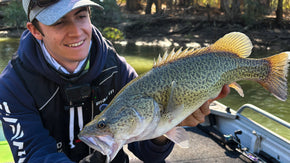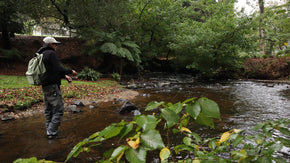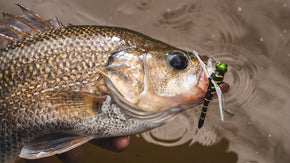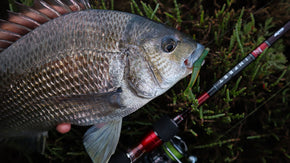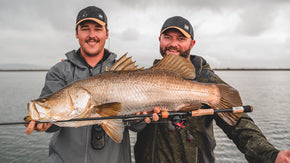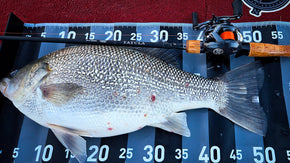Posted 19th July 2024
Squiding the Stones


By Joshua Bland
Southern Calamari in the last few decades have skyrocketed to become one of the most recreationally targeted species in Australia’s southern waters. In South Australia, they are the third most recreationally sought-after species, with an estimated 220,000kg being caught each year.
Calamari are uniquely found at the crossroads of accessibility, approachability, and culinary appeal. In other words, they are found just about everywhere, they are easy to catch, and they taste great. So, it’s no wonder their popularity has surged and that they are now experiencing more pressure than ever before.
Lucky for them, squid are fast to grow up and quick to get down, meaning these populations remain sustainable despite the pressure. However, the increased pressure can make finding ways to catch them harder and harder, particularly in the most densely populated areas.
If you live in suburbia like me, your jetties are bustling most mornings and nights, making it increasingly difficult and often frustrating to catch a feed. This is where you need to branch out to locations most people don’t go. For me, it’s a stone’s throw away.

Environment
Rocky coastlines are some of the most beautiful environments we get to experience as anglers, but they have their challenges. These environments are harder to access, require a stronger skillset, and often require more specialised gear. These factors filter many searching for an easy option and provide ambitious anglers with an opportunity. These locations often grant you access to drop-offs, weed beds, reefs, and gravel bottoms all within casting distance. These types of complex habitats are all things calamari love.
Do note that these habitats come in a variety of different forms from deep drop-offs to deep water to shallow boulder-laden beaches. My local consists of a moderate drop off into 1-2.5m of water with nearshore rocky bottom that transmutes into seagrass and cork weed beds. The following advice is given with that habitat in mind.
It is important to note that safety is paramount in these locations. Read Alex’s rock fishing safety advice before going out.
The perfect conditions
Fishing from the stones is less accessible than the local jetty, this makes the time and conditions you go out in more critical. Lucky for us, the best conditions for rock fishing align with the best conditions for targeting these soft-bodied predators.
Calamari are delicate and tend to avoid turbulent wash or strong currents. They have large, hyper-sensitive eyes meaning they tend to favour low-light conditions. This means the perfect conditions are dawn and dusk when the sea is calm, usually on either side of a high tide though low tide at my local is easier to fish.
Under these conditions, squid push nearer to shore in search of prey. Sometimes you’ll catch them at your feet as they patrol the dark shallows for a meal. These areas, a cast length from the shore, are often overlooked by boat and kayak fishers. I have had great success in front of struggling boaters, simply by taking advantage of this behaviour.

Technique
There are two main ways I target calamari from the rocks – active and passive.
Active
Active is your traditional, direct to jig, egiing method. Uni knot to your jig on a short leader (one rod length or less) in 15 – 30lb to help pull your jig free when you get it snagged. Why the short leader? Even with an FG knot, casting hard and far with heavier leaders is risky. Catching guides can happen with longer leaders, snapping lures off or causing some sort of damage. I’ve done it before, so I run it short and take it easy on the squid when I hook up.
Count your pauses. Allow the jig to sink to the bottom on the first cast but count it down as you do. Now for each hop you do with the jig, you have an idea of how long it takes before it’s in the danger zone. Use the counting method to ensure you are working the jig 1m off the bottom, right in the strike zone.
The Emeraldas Peak jigs do short hops remarkably well through their uniquely designed front weight. This gives you variety in action from large traditional egiing rips to subtle twitches over the bottom. Experiment on the day, sometimes a slow roll with no action at all is dynamite.

Passive presentation
This is a classic squid-catching method. Tie your leader to a swivel attached to a 1 – 2m leader, thread on a large, weighted float and finish with a jig. The length of the leader will be the depth the jig will sink to, but you are also limited by your rod length. Cast this into or ahead of the zone you wish to fish and allow it to drift through the honey hole as slowly as possible. Simply reel it in gently when the float disappears. This can be a ruthlessly effective method and often saves you from losing jigs due to the set depth.

The gear
Gear becomes far more critical for this style of fishing. You will be making long casts with smaller-sized jigs most of the time, so a long graphite rod is invaluable. The kind depends on the size jig you are casting and the presentation you choose which I will simplify to two main techniques – active and passive. I will go into this more in the next section.
Active presentation
For the active presentation – the Emeraldas series, whether it’s the X or the MX, are the best picks. Pick the model with the right cast weight for the jigs you’ll use most. I like the extra length from the 8’6” variants which give you a slight edge over distance. For my local in South Australia, the EMERALDAS X 86ML or the 20 EMERALDAS MX 86ML.E depending on your budget fit the bill perfectly.
But what if you don’t want a dedicated squid rod? The good news is you can get away with other options if you don’t do this style of fishing often. A 7-7’6”, medium-action, fast taper rod with a max cast weight of 15-20g will still perform well. I often find myself grabbing my school mulloway rod (22 TD ZERO 742LXS) for this purpose.
Pair these rods with a 2500 – 3000 reel spooled with PE 0.8 – 1.0 braid and you are set. Again, look to the Emeraldas series of reels for something with the ideal gear ratio but reels like the 21 Freams FC LT or 21 Caldia are nice mid-range alternatives with good corrosion resistance.
Passive presentation
For the passive presentation, look to surf rods – the SEABASS and SEAJIGGER series are some of my favourites. Pick something between 9 and 11 feet long with the right cast weight. Remember, you need to factor in the weight of your rig/float. I like the 23 SEAJIGGER 1002ML and the 23 SEABASS 1062M. Just quietly, these are surf slug casting monsters or great for bait fishing the rocks too.
Pick a reel to balance such as a 3000 – 5000 using your judgement here. This reel should be picked with another species/technique in mind since the reel is simply there to bring the squid in and balance with the rod. I use my salmon surf combo which has a 5000 spooled with PE 1.5 braid.

Jigs
Now for jigs. There is enough research out there for you to make an informed decision. Just be confident in your choice. I prioritise contrast over colour, one way to assess a colour for its contrast differences is to take an image of the colour range and make the image monochrome by removing the saturation. I like to have both rattling and silent versions (Emeraldas Peaks come in both). Cycle through options till something sticks.
Wrap up
Egiing the stones can be a very productive form of fishing for calamari when the usual land-based options are bustling with people. Whilst it’s often less productive than boat or kayak access where you can follow the squid, it makes a great short session option around first and last light. So next time you're shoulder to shoulder on the jetty with not a squid in sight, think to venue out to the more hard-to-reach places and you may be well rewarded.









